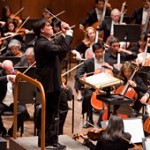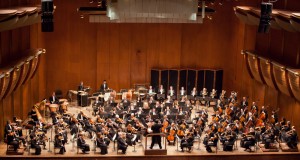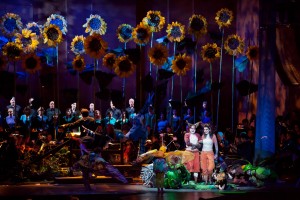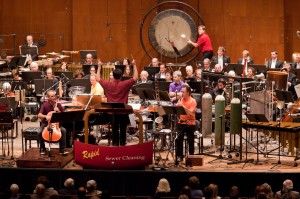by Sedgwick Clark
The 2012-13 season began at New York City Ballet with a three-program mini-festival of Stravinsky-Balanchine works. It ended last week with Alan Gilbert and the New York Philharmonic in a “theatrical reimagining” at Avery Fisher Hall of Stravinsky’s Le Baiser de la fée (The Fairy’s Kiss) and Petrushka. May 29 was the 100th anniversary of the scandalous first performance of Le Sacre du printemps. I took on listening to 49 recordings in a pair of historical collections from Decca and Sony Classical. That took longer than the week I had anticipated, domestic matters and other deadlines being what they are, but the results of my listening sessions—with my new comments in blue—are finally posted in toto below.
Alan Gilbert’s Stravinsky—A Dancer’s Nightmare
In each of his four seasons so far, New York Philharmonic Music Director Alan Gilbert has ended with a Major Project. First, Ligeti’s opera Le Grand Macabre, then Janáček’s opera The Cunning Little Vixen, and last season a program of works for multiple orchestras at the Park Avenue Armory: Stockhausen’s Gruppen, Boulez’s Rituel, an excerpt from Mozart’s Don Giovanni, and Ives’s The Unanswered Question. All daring, to say the least, and all smashing successes with the public and critics.
Everyone’s doing Stravinsky this year due to the centennial of Le Sacre, so Gilbert coupled two ballets for his fourth extravaganza: the rarely performed Le Baiser de la fée (The Fairy’s Kiss) from 1928 and the enormously popular Petrushka (1911).
First, the good part. The musical portion of the program was first-rate. The Philharmonic musicians played beautifully, and Gilbert was at his best. He’s not a ballet conductor, and Baiser’s opening minutes meandered a bit, lacking point and accent. But the music quickly assumed its idiomatic Stravinskian rhythmic profile, and the ending, which in lesser hands can seem overlong, was quite lovely. Le Baiser is Stravinsky’s homage to Tchaikovsky, utilizing many of his lesser-known melodies (mainly piano works). A moment from the Fifth Symphony flashes by, but the only truly familiar piece borrowed for any length of time is Tchaikovsky’s song None but the lonely heart as the climax of the work. As for Petrushka, Gilbert elicited a magnificent performance. But the dance and staging portion of the evening was a perfect example to those who believe that orchestras should stick to orchestral music, for which they were created. Hard on the heels of Gilbert’s distinguished, straightforward concert presentation of Luigi Dallipiccola’s opera Il Prigioniero (6/6), this Stravinsky program, marketed as “A Dancer’s Dream,” was embarrassingly cutesy.
As I’ve admitted before, I’m not knowledgeable about the ballet; I go primarily when the music interests me. But the choreography, by Karole Armitage, struck me (and several others who are balletomanes) as amateurish and the use of New York City Ballet Principal Dancer Sara Mearns as a colossal waste of talent. I was astounded to read Alastair Macaulay in the Times: “The choreography, by Karole Armitage, could only have a limited effect in conditions so cramped, but individual phrases very much along Balanchine lines, beamed out powerfully.”
49 Recordings of Le Sacre du printemps – Finished at Last!
It may seem unnecessary to audition and report on 49 recordings of Stravinsky’s Le Sacre du printemps (The Rite of Spring) since 38 of them can be obtained only in a single set from Decca and another 10 from the Columbia and RCA catalogues in a set from Sony Classical. But if fellow Stravinskyites relish my Sacre orgy, they might be persuaded to acquire these sets too and have an equally pleasurable wallow. In a day when any professional orchestra can whiz through the piece without blinking, it’s fascinating to hear the oldest recordings and realize how daunting Le Sacre once was.
My preferred recordings in these sets are listed below, in order of preference.
Clark’s Top 6
• Columbia Symphony/Igor Stravinsky (1960; 31:35). Sony
• Boston Symphony/Pierre Monteux (1951; 31:25). Sony
• Cleveland Orchestra/Pierre Boulez (1969; 34:34). Sony
• Boston Symphony/Michael Tilson Thomas (1972; 34:00). Decca
• Chicago Symphony/Georg Solti (1974; 32:12). Decca
• Berliner Philharmoniker/Bernard Haitink (1995; 32:48). Philips
Sony Classical’s Centenary Releases of The Rite of Spring
Igor Stravinsky – Le Sacre du Printemps – 100th Anniversary Collection – 10 Reference Recordings
CD 1
Philadelphia Orchestra/Leopold Stokowski (1929/1930). Shocking! In our day of recorded perfection, it’s difficult to say which of Le Sacre’s first three recordings, is the worst played: Monteux, Stravinsky, or this Stokowski, all recorded within a year of each other. RCA’s 78s are more vivid sonically than this CD or any LP transfer I’ve heard—enough so that a recent spot check revealed the kind of sensuous details that separated him from nearly every conductor of the 20th century, and which I never noticed before. I’m glad Sony included it, but non-collectors may find listening a chore. (32:39)
CD 2
New York Philharmonic-Symphony Orchestra/Igor Stravinsky (1940). A very tight reading. One wishes he would relax a little and invest the music with more expressiveness at times, but the New Yorkers do well by the score, with only occasional imprecision, until they stumble over the rhythmic complexity of the concluding Danse sacrale. Still, it’s a huge improvement over his 1929 Paris recording. The 78s have notably more presence and tonal warmth. The recording date, by the way, is April 29, 1940, not April 4, as the back of the package states. (30:45)
CD 3
Boston Symphony/Pierre Monteux (1951). Monteux conducted the infamous first performance of Le Sacre. He made four recordings, and this is far and away his best. The BSO players seem to be playing on the edge of their seats with commitment, and a few scrappy moments—most in the Danse sacrale—hardly detract from this great, well-recorded performance. (31:35)
CD 4
Philadelphia Orchestra/Eugene Ormandy (1955). Ormandy reportedly maintained that he never conducted Le Sacre. It certainly isn’t his piece. Timpani are muffled throughout, and woodwind details are often obscured by Philly’s glamorous strings. This is its first release on CD, sounding rather dim from what I take to be its LP work tape rather than the master source. Too bad Sony didn’t include Ormandy’s Petrushka Suite from the LP, which is more his style. (29:49)
CD 5
Columbia Symphony/Igor Stravinsky (1960). The composer’s stereo recording of Le Sacre (as well as his 1940 mono recording with the New York Philharmonic-Symphony, which is only 50 seconds shorter) has unrivalled rhythmic accentuation, clarity, and balletic character. There are more exciting, splashily recorded versions, but this performance simply feels “right.” (31:35)
CD 6
Chicago Symphony/Seiji Ozawa (1968). I was at Ravinia, the CSO’s summer home, for the concert preceding the recording session. It was exciting then and it is now, even if the performance style is somewhat generalized. But it’s superbly played, and a sad reminder of the promise Ozawa had that was never quite fulfilled. He tightens the pace at the end as Monteux did, no less effectively. (32:46) Fireworks from the original LP is included first, as before.
CD 7
Cleveland Orchestra/Pierre Boulez (1969). The French conductor’s 1963 Paris recording was fast, fiery, and on its toes. But he came to feel, he said to me in an interview, that such febrile tempos trivialized the work. This Cleveland performance can seem a bit earthbound at times, but following the score reveals all sorts of details that other conductors gloss over and that Boulez reveals without calling attention to them, such as the three accented trumpet notes on page 31 that so many treat indifferently (but not Ormandy!). The players are at their best, and the recording is the utmost in clarity. (34:34)
CD 8
London Symphony/Leonard Bernstein (1972). The best thing about this Sacre is the faux Rousseau, pop art cover. It’s a surprisingly tepid Sacre from this most un-tepid conductor. Originally recorded for quad by producer John McClure, the wet acoustic obscures much detail. (35:29)
CD 9
Philharmonia Orchestra/Esa-Pekka Salonen (1989). Hopelessly flashy. The slow tempos are very slow, and the fast ones very fast in this absurdly bifurcated Sacre. It’s very exciting but counterproductive to any musical continuity and impossible to dance to. His later DG recording is more traditionally paced. (32:13) A fine Symphony in Three Movements is included from the original CD release.
CD 10
San Francisco Symphony/Michael Tilson Thomas (1996). MTT remains a master of Le Sacre with all the details so often missing in other performances right in place, superbly played and recorded. The Glorification and Evocation sections may seem a bit hasty, but they stir the blood. (34:54)
Stravinsky conducts Le Sacre du Printemps
CD 1
Le Sacre du Printemps (1960). See CD5 above.
Firebird Ballet Suite (revised 1945 version). Columbia Symphony Orchestra/Igor Stravinsky (1967). Stravinsky’s most popular and frequently performed piece is the 1919 Suite from The Firebird ballet. But it was not under copyright and he never made a dime from it. So in 1945 he arranged and reorchestrated a new suite, adding several dances from the complete ballet. Most orchestras continued to perform the 1919 suite, however, because they didn’t have to pay royalties for it. I listened to this “bonus” stereo recording directly after hearing his 1946 recording. What a difference in the expressiveness of his conducting; the music breathes with rubato, affection, and breadth, especially in the horn solo and strings of the Final Hymn, before the brass fanfare of Palace Merrymaking. It’s as if he knew it would be his final recording. And indeed it was. (29:24)
CD 2
Le Sacre du Printemps (1940). See CD2 above.
Firebird Ballet Suite (revised 1945 version). New York Philharmonic-Symphony Orchestra/Igor Stravinsky (1946). This new suite was hot off the presses when Stravinsky recorded it. But some transitions were abrupt—especially jarring between the Berceuse and Final Hymn—and before the score was printed he added three Pantomimes and brief transitional material, totaling about three minutes. It’s good that Sony decided to include these two Firebird suites and allow us to hear a great composer at work. (26:00)
Decca’s Complete Collector’s Edition: Le Sacre du printemps
CD 1
Concertgebouw Orchestra/Eduard van Beinum (1946). The oldest Sacre in this set, it is remarkably well played and conducted. Tempos are similar to the composer’s. It lacks the detail of modern recordings, of course, but it’s full of atmosphere. Timpani mostly inaudible. Fine transfer, with no audible 78 joins. (32:08)
L’Orchestre de la Suisse Romande/Ernest Ansermet (1950). Ansermet was one of Stravinsky’s great early champions, but his recordings are mere curios today. The insufficiencies of his Suisse Romande are all too clear, as are his devitalized interpretations. His 1957 stereo remake is no improvement. (33:56)
CD 2
RIAS Symphonie-Orchester Berlin/Ferenc Fricsay (1954). At last a recording of Le Sacre in which the timpani make their proper effect (even if the bass drum is weak)! An excellent performance, if perhaps bit too sane. (33:39)
Minneapolis Symphony/Antal Dorati (1954). A CD first. A driving, dynamic performance with all the crucial instrumental details powerfully captured in their correct acoustical space by Mercury Living Presence’s single mic. The Dance of the Earth and Danse sacrale are incredibly exciting, and the timpanist is on fire. The 1959 stereo remake is faster, seeming frantic and lightweight. (31:18)
CD 3
Orchestre des cento soli/Rudolf Albert (1956). The sleeper of the set. Decca couldn’t even find a photo of Albert! Well paced and played, it only flags a bit in the last pages of the Danse sacrale, as one imagines the exhausted virgin dancing herself to death would. The few instances of imprecise ensemble are of no concern. The German-born Albert was a contemporary-music exponent, and a few weeks after leading this recording he conducted the world premiere of Messiaen’s Oiseaux exotiques. (33:37)
Paris Conservatoire Orchestra/Pierre Monteux (1956). There are several pirate Monteux Sacres on the market, but this was his fourth and final studio recording and the only one in stereo, produced by John Culshaw. On paper it looks promising and authentic (French maestro who conducted the work’s first performance, French orchestra, recorded in Paris’s Salle Wagram), but the fact that it was recorded over a nine-day period may indicate that there were extra-musical reasons for the lackluster leadership and lax ensemble. The 1951 Boston on Sony is best. (32:57)
CD 4
L’Orchestre de la Suisse Romande/Ernest Ansermet (1957). (33:52) See CD1.
Minneapolis Symphony Orchestra/Antal Dorati (1959). (29:56) See CD2.
CD 5
Berliner Philharmoniker/Herbert von Karajan (1963). Stravinsky criticized this performance as “a pet savage rather than a real one . . . . There are simply no regions for soul-searching in The Rite of Spring. Berlin’s “sostenuto style is a principal fault,” he continues. “The music is alien to the culture of its performers.” It’s a fascinating performance, with many instrumental felicities, but it’s ultimately a curio, which goes for its 1977 remake as well. (33:48)
London Symphony/Colin Davis (1963). A young man’s Sacre—exciting, athletic, well played for its time. Well recorded. (30:29)
CD 6
Los Angeles Philharmonic/Zubin Mehta (1969). The first “modern” recording from these labels, with obvious multi-miking, deep bass drum, and exaggerated timpani, as if you were onstage. The Danse sacrale is exciting and well played, which characterizes the entire performance. It may not be your ideal seat in the concert hall, but “Wow!” (32:54)
Boston Symphony/Michael Tilson Thomas (1972). Excellent playing and conducting, recorded naturally in Symphony Hall’s gorgeous ambient warmth. If occasional detail is lost, the aura of a genuine concert makes up for it. Tilson Thomas told me soon after the sessions that this was the only recording, including the composer’s own, that followed the metronome marks precisely. Whatever the case, it remains one of the best. (34:00)
CD 7
London Philharmonic/Bernard Haitink (1973). The low-level volume is not all that needs a boost, despite careful instrumental balances. (34:07)
London Philharmonic/Erich Leinsdorf 1974). Stolidly conducted, with distracting Phase 4 balances. I wonder if Leinsdorf was standing in for another maestro taken ill, as I enjoyed his sumptuous Sacre with the Boston Symphony in fall 1968 at Lincoln Center. (33:26)
CD 8
Vienna Philharmonic/Lorin Maazel (1974). This version was panned for unidiomatic playing by the VPO and Maazel’s eccentricities, but over headphones the playing is mostly accurate and quite beautiful–perhaps not what one wants in a Sacre, but interesting nonetheless. Then there are those 11 fortissimo chords that lead into the Glorification of the Chosen One section, which Maazel has the Viennese play ludicrously slow and meaty, and several other yucky protractions of brass glissandi. Of interest to the curious. His New York Phil performance during his tenure was thankfully less vulgarized. (33:41)
Chicago Symphony/Georg Solti (1974). Superbly played, no eccentricities, closely recorded. Minor imprecisions in the Glorification section prove that the musicians are human, but no matter. This is a mind-blowing Sacre, truly virtuoso, highly recommended. (32:12)
CD 9
London Symphony/Claudio Abbado (1975). A fine performance, powerfully recorded, with plenty of excellent details from the LSO, such as a fast, sinister bass clarinet before the Danse sacrale. But as usual with Abbado, I don’t hear much character in the playing to complement the precision—certainly nothing approaching Solti/Chicago. (33:17)
Concertgebouw Orchestra/Colin Davis (1976). Unlike Davis’s fiery, if not always precise, LSO recording of 13 years before, the plush CGO sonority and reverberant hall cover detail, and the conducting is overly gentlemanly. Very beautiful if that’s what you want. A tape-editing error on LP repeated the four bars after number 192 in the Danse sacrale, but the CD is correct. (34:47)
CD 10
Berliner Philharmoniker/Herbert von Karajan (1977). (34:18) See CD5.
National Youth Orchestra/Simon Rattle (1978). The most memorable live performance of Le Sacre I ever heard was Boulez leading the 145-player National Youth Orchestra of Britain in London in spring 1977. Also on the program was Bartók’s MUSPAC, with 16 double basses and an equal complement of the other strings, and Berg’s Violin Concerto with Itzhak Perlman. Boulez was in ecstasy afterwards, for good reason. Rattle’s is a capable performance marred by a stodgy Glorification of the Chosen One and Danse sacrale. (33:33)
CD 11
Boston Symphony/Seiji Ozawa (1979). His lack of exaggeration is welcome. For instance, he resists the crass distention of the brass glissandi toward the end of Spring Rounds (number 53) that most conductors indulge in. Also positive are the BSO’s excellent playing and the ideally resonant Symphony Hall acoustics. But the vicious attacks in Part 2 are too well-upholstered, and the Danse sacrale flows too smoothly, too predictably, too much like Karajan’s pet savagery. (32:37)
Detroit Symphony/Antal Dorati (1981). The first digital recording in this set. The bass drum will blow you out of the room, and it’s clearly differentiated from the timpani. But it’s rather tired—as much an old man’s performance as his 1953 Mercury one was palpably a young man’s. (33:31)
CD 12
Israel Philharmonic/Leonard Bernstein (1982). No room for soul-searching, Lenny. Stick with the Royal Edition CD of the 1958 New York Philharmonic recording. (36:57)
Orchestre Symphonique de Montréal/Charles Dutoit (1984). Warm, glowing sonics, with plenty of space around the instruments. I wish he hadn’t emphasized the brass glissandi at number 53, but there are worse. (35:08)
CD 13
The Cleveland Orchestra/Riccardo Chailly (1985). Less soft-edged than than most of his Stravinsky recordings, and there is certainly no reticence from the battery, but it’s a superficial performance overall. (32:34)
The Cleveland Orchestra/Pierre Boulez (1991). Boulez’s third outing, recorded in the resonant Masonic Auditorium, has a more distant concert-hall balance in the DG tradition. Many details are less clear than on his 1969 Cleveland recording in the Sony box above—some shockingly so, such as the inaudible forte solo horn soon after the Dance of the Earth begins, specifically notated in the score and absolutely clear in the drier Severence Hall acoustic. Timpani, too, are not always as clear on DG in the Danse sacrale. But some may prefer this less detailed Sacre, for it is marginally more expressive and never seems studied, as the 1969 recording does on occasion. (33:15)
CD 14
Royal Concertgebouw Orchestra/Georg Solti (1991). Solti nails many details that other conductors either exaggerate or overlook, but the overall impression of this live recording is less than the sum of its parts. Occasional scrappy moments mar the generally fine ensemble, and the sound is a bit pallid. Moreover, the Danse sacrale plods, with no rhythmic lift. In concert, without competition from such superior versions as Solti’s own Chicago recording, this might not seem so bothersome. (33:55)
The MET Orchestra/James Levine (1992). A brutish Le Sacre. Many percussion details are clear at last, but then the timpani and trombones at the beginning of Ritual of the Rival Tribes are (like several others) not quite together. The Dance of the Earth’s buildup gains in volume but not excitement; compare it with the 1953 Dorati and 1951 Monteux who increase the tempo and raise you off your seat. Likewise, the Danse sacrale is just noisy and percussive.
CD 15
Deutsches Sinfonie-Orchester, Berlin/Vladimir Ashkenazy (1994). Very quiet introduction. Fine timpani playing. But in Part 2, Glorification of the Chosen One is surprisingly tame. Ritual Action of the Ancestors is admirably steady, and the bass clarinet before the Danse sacrale is frightening. But the Danse itself is dogged rather than relentless; there’s no build and terror. Still, it’s worth a listen. (34:29)
Orchestre de Paris/Semyon Bychkov (1995). Unexceptionable, with good details here and there, but nothing to compel relistening. (32:29)
CD 16
Berliner Philharmoniker/Bernard Haitink (1995). The Dutch conductor’s second Sacre is, again, by the letter of the score. But this time he has at hand the peerless Berliners instead of the workmanlike London Philharmonic (see CD7), and all sorts of details reveal themselves by sheer dint of individual instrumental virtuosity and eloquence. Producer Volker Straus seems, as well, to be more liberal with spot mics than 22 years ago, when Philips’s recording philosophy was more a photograph than a sonic creation in itself. This is a superior rendering of what Stravinsky composed. (32:48)
Kirov Orchestra, St. Petersburg/Valery Gergiev (1999). This is touted as a uniquely Russian interpretation in some circles, but I wonder if it’s just uniquely Gergiev, with the usual not-quite-precise Mariinsky playing. It’s certainly quite unlike the composer’s transparent textures and crisp accentuation. The introduction is slow and expressive. The young girls heavily stamp the Augurs of Spring, and the Spring Rounds are ponderous, with grossly exaggerated trombone glissandi. (I wonder if he had Fantasia’s dinosaurs in mind.) The Dance of the Earth is exciting but thick-textured, and Gergiev oddly appears to pull up slightly on the last note. In Part 2, moderate tempos in the Evocation and Ritual Action of the Ancestors and the Danse sacrale are very effective. The timpani playing is unlike any other performance I’ve heard, alternating between loud thwacks and inaudibility, and the final two chords are played after a very long pause. (34:35)
CD 17
Los Angeles Philharmonic/Esa-Pekka Salonen (2006). Unlike his 1989 Sony recording, tempos are traditional. Still, there’s nearly always something in a Salonen performance that pulls me up short and makes me think, “Why the hell did he do that?” At the end of Part 1’s Dance of the Earth he has the horns hold their note longer than the cutoff of the rest of the orchestra. It was all I could do to force myself to listen to the rest of the recording. (32:59)
Orchestre Philharmonique de Radio France/Myung-Whun Chung (2007). A fine performance, often exciting, but unexceptionable, without challenging my favorites.
CD 18
Simón Bolívar Youth Orchestra of Venezuela/Gustavo Dudamel (2010). Not only a young conductor’s performance: The engagement of every last Venezuelan instrumentalist is palpable in every note. It may not be the ideal Sacre: For that, get an old man’s performance, the composer’s recording.
Four hands: Bracha Eden, Alexander Tamir (1968). Not bad overall, but there’s little personality to the reading, and of course Le Sacre for four hands—even as transcribed by the composer—is but a study. (34:05)
CD 19
Four hands: Güher and Süher Pekinel (1983). As faceless as Eden and Tamir are, the Pekinel twins are personality personified. But it’s an alien personality, with expressive shading, prim rhythms, and lightweight tone that emphatically do not belong in this piece. (33:22)
Four hands: Vladimir Ashkenazy, Andrei Gavrilov (1990). Of these three four-hand piano transcriptions, this is the one that sounds like a genuine interpretation of the piece, with tempos and textures that one who knows the orchestral version would recognize. Its only drawback is the Danse sacrale, which is played so fast that it seems insubstantial. (33:34)
CD 20 – Bonus CD
Violin Concerto
Samuel Dushkin violin, Lamoureux Concert Orchestra/Igor Stravinsky (1935). To no surprise, Stravinsky’s first recording of his Violin Concerto has the same interpretive parameters as his 1961 recording with Isaac Stern. Also, to no surprise, Stern plays the slow movement with more juice. Both recordings are welcome. (20:59)



